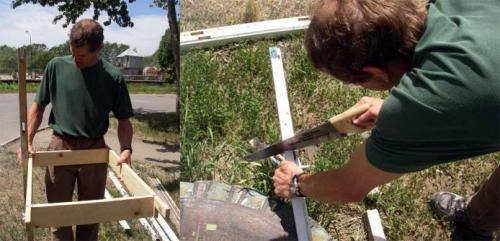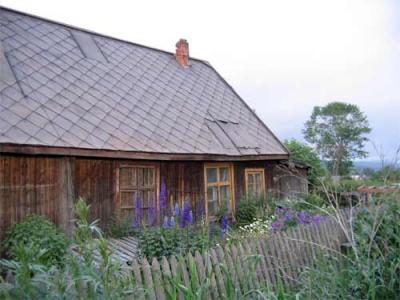A little after noon on our last day in Yuzhno-Sakhalinsk, Mike Etnier and I took some salvaged pieces of wood from window frames that we found near the dumpster out to the playground area between the apartment buildings. We are going to use the pieces of wood to make legs and braces for the screens.
Back in Washington, Mike had cut and pre-constructed the pieces for two more frames screens to go with the one that we have from last year. The pieces have not yet been put together, but were brought to Russia dismantled, along with the hardware to reconstruct them.
The screens are made from a wooden frame rectangle that is about 2 foot by 3 foot in dimension and about 4 inches high. Then a piece of hardware cloth "mesh” with either ¼ inch or 1/8 inch squares is stretched across the bottom of the frame. Two of the frames rest together so that the ¼ inch frame can fit right on top of the 1/8 inch frame. Then the dirt that is removed during an excavation is shoveled into the screens and sifted. Since the frames fit together you can screen out the bits, such as bone, artifacts or charcoal, that are bigger than ¼ inch and those that are smaller than ¼ inch but bigger than 1/8 inch at the same time.
We needed to cut pieces the salvaged wood to be used to legs for the screens to the right length and to cut braces for the legs. The screens are designed so that two people hold the handles on each side and together sift the dirt through by shaking the screen back and forth. The legs will be attached to one side of the screen to hold it up so that it can be operated by one person.
Mike measured roughly how high the legs should be for the average person and then we cut three sets of legs, with one set a little longer than the other two. After that, we measured and cut cross braces for the legs that will be added in a little "x” near the feet of the legs. That will make them more stable so that the screen will (hopefully) not fall over while it is being used.
Building frames
 Left: Mike Etnier measures the height for the legs of a shaker screen frame. The frame will be used to sift dirt from an archaeological excavation to recover small bits of bone, stone or charcoal. Right: Mike Etnier cuts one of the legs for the shaker screens. The legs will be used to support one side of the frame so that they can be operated by one person or they can be removed so that two people can shake the frame.
Left: Mike Etnier measures the height for the legs of a shaker screen frame. The frame will be used to sift dirt from an archaeological excavation to recover small bits of bone, stone or charcoal. Right: Mike Etnier cuts one of the legs for the shaker screens. The legs will be used to support one side of the frame so that they can be operated by one person or they can be removed so that two people can shake the frame.
After we finished with the job, we put the leftover pieces of wood back by the dumpster (in case someone else wanted to salvage them), threw away the small unusable bits and put the tools and our cut pieces away.
After dinner, Ben, Shelby and I took an exploratory walk through the neighborhood. We head further north, away from the Institute into areas that we hadn’t been before. We found some trails along the small river, some more passable than others, and managed to avoid the puschki, plants that have an oil like poison ivy that will give you a nasty burn or rash, and only encountered a few mild brushes with nettles. Eventually, we found a bridge across the river and wandered for awhile through an area of the neighborhood where people had small houses and gardens. These sorts of country homes are called dachas and are often owned by extended families. Each family’s dacha garden might provide most of the fresh foods that they eat and preserve for the winter. Some of the houses were more run down than others and some were probably only occupied in the spring and summer time, but all of them had very nice, productive vegetable gardens surrounding them and some had very pretty flower gardens as well.
Russian Dacha
 Russian Dacha
Russian Dacha
A Russian dacha house with its flower garden in bloom. Dachas are the country houses of Russian families where they plant flowers and large vegetable gardens to grow all of the produce for the family for the year. Typically dachas are only lived in during spring and summer months and may not be very fancy on the outside, but are very comfortable to live in during nice weather. (Photo courtesy of Shelby Anderson)
We wandered for about an hour through the dachas and then headed back to the apartment to get ready for bed and our big day of moving to the ship the next day.
Spokonye noche (good night)!
Misty

